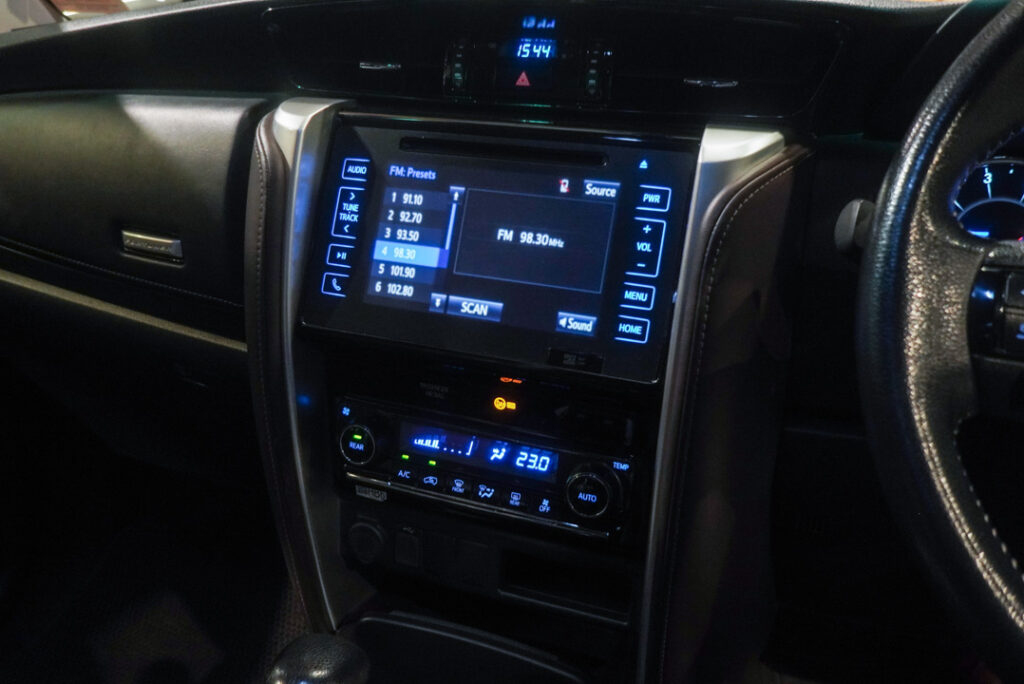© Copyright 2024 - All Rights Reserved - SK Car Lounge Pvt. Ltd.
Designed & Developed by www.aivah.com
Designed & Developed by www.aivah.com





The original Toyota Fortuner sigma 4 was an enormous, powerful machine that made all manner of cars humbly move out of its way. The automotive equivalent of the mighty elephant, other cars gave it a respectfully wide berth and no one messed around. Now though, the handsome brute has had a makeover that has taken it…
The original Toyota Fortuner sigma 4 was an enormous, powerful machine that made all manner of cars humbly move out of its way. The automotive equivalent of the mighty elephant, other cars gave it a respectfully wide berth and no one messed around. Now though, the handsome brute has had a makeover that has taken it from rough and wild to suave and polished.
Think of it as Sylvester Stallone finishing up a gruelling day of killing commies on the sets of Rambo and then cleaning up to attend the Oscars. Sure, he looks all smart and sophisticated, but you know damn well that lurking under that sleek tuxedo is a mass of pure muscle that will crush you up like a paper ball without breaking a sweat.
In that sense, the new Toyota Fortuner Sigma 4 still gets the same respectful distance in traffic, but it is preceded by something new – people now stare and point. Those sleek and flashy lights along with the huge chrome grille and pinched rear window line really do stand out. It may look different but it’s still massive, even bigger than the old Fortuner in length, width and height, while wheelbase remains the same.
Those who like to be seen will love what this Toyota can do for their image. I like it too, but there are some things I’m not completely fond of. The giant vertical chrome bars on either side of the grille seem out of place, and I’m worried that these fresh metrosexual looks take away from the Fortuner’s rugged intent. For example, I’m not sure how a heavy-duty Ironman style metal bumper.
The fact is that the Toyota Fortuner Sigma 4 has a supremely commanding driving position! The cabin itself has received a big overhaul and while it isn’t exactly royal, it’s a big step-up. In typical Toyota fashion, the cabin isn’t a revolutionary or stunning design but simply feels very well put-together and built to last. The leather and faux metal trim on the centre console add some class, but the simple digital clock and climate control panel could have easily come off a car from the last decade.
Below the single-zone climate control unit lie big, chunky buttons for ESP, hill hold and a new rotary knob for the four-wheel drive system. While the old Fortuner was a full-time four-wheel drive, this one gives you the choice to shift from the standard two-wheel drive to four-wheel drive. There’s also a four-wheel drive low ratio for when you get into very sticky situations.
The last row also feels a little closed off thanks to the reduced rear window line. Middle and rear passengers are kept comfortable by a roof-mounted AC and there is a charging port in every row. The Toyota Fortuner Sigma 4 has an electric-opening tailgate and an auto up-down feature for all windows. Both are nice features but it also lacks in some areas – there’s no sunroof, the outside mirrors don’t auto-fold and the inside mirror doesn’t auto-dim at night.
The Toyota Fortuner Sigma 4 runs the same 2.8-litre turbo diesel from the Innova Crysta, and it provides strong performance. The motor feels more modern than the outgoing 3.0-litre D4d diesel engine in almost every way. The Toyota Fortuner Sigma 4 engine is more rev happy and provides more eager performance. At 177PS, it also makes 6PS more than before, but torque has shot up substantially, from 343Nm to 450Nm on the automatic (the manual version gets 420Nm).
The engine is quite refined with both roughness and the typical diesel clatter well controlled, but it does have a rather loud note. The Toyota Fortuner Sigma 4 gets a 6-speed automatic gearbox with the choice to manually shift gears either through the shift lever or by steering-mounted paddles. Strangely, whenever manual mode is selected, the digital screen in the instrument cluster indicates that the car is in 4th gear, even if you’re crawling in what is obviously first gear traffic. Changing gears after this causes in change in the number displayed but it isn’t always accurate.
The Toyota Fortuner Sigma 4 offers an Eco mode that reduces throttle response and sets early gear shift point. There’s also a Power mode that makes the car feel noticeably quicker with sharper responses and allows the gearbox to hold onto gears for longer. Despite its bulk, the Fortuner isn’t too much of a slouch taking 12.3s from 0-100kmph and with plenty of surge available on demand for quick overtakes. Likewise, braking is impressive as well the Fortuner coming to a dead stop from 100kmph in 3.2s and 43.8m.